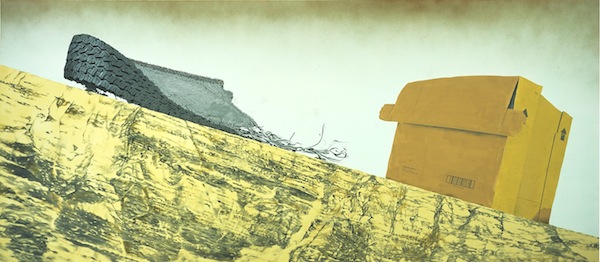 © Ed Ruscha. Psycho Spaghetti Western #9, 2010-2011 | Acrylic on canvas, 64 x 80 inches. Courtesy Gagosian Gallery.
© Ed Ruscha. Psycho Spaghetti Western #9, 2010-2011 | Acrylic on canvas, 64 x 80 inches. Courtesy Gagosian Gallery.
Tucked away in a busy corner of Beverly Hills, a stone's throw from the clamor of Rodeo Drive, is Gagosian's mammoth new Los Angeles space. Within it is housed Ed Ruscha's first show of new paintings in L.A. in a staggering twelve years. It's a major homecoming, and the ten wide, horizontal works exhibited here, known affectionately as Psycho Spaghetti Westerns, represent not so much a departure for Ruscha, but rather a means by which to further contextualize his previous bodies of work while doing what he does best: laconically re-examining America.
More than any other American artist in the last 50 years, Ruscha has made a career of redefining the American landscape. His Course of Empire series, which represented the United States at the 51st Venice Biennale in 2005 and was later exhibited at The Whitney, is the source material in a sense for Psycho Spaghetti Westerns, which are mildly abstracted, detritus-filled extensions of his acclaimed 2005 series. Course of Empire was itself a new take on a previous series, taking the old manufacturing buildings of Ruscha's Blue Collar Paintings of the early '90s (and their angled perspective), and allegorizing the changes of globalism and economic decline.
 © Ed Ruscha. Psycho Spaghetti Western #5, 2010-2011 | Acrylic on canvas, 48 x 110 inches. Courtesy Gagosian Gallery.
© Ed Ruscha. Psycho Spaghetti Western #5, 2010-2011 | Acrylic on canvas, 48 x 110 inches. Courtesy Gagosian Gallery.
A master of both Americana and consistency, Ruscha and his new paintings don't stray too far from the same idea. The angles of the diagonal rooftops depicted in his two previous bodies of work appear revisited here in the form of 'slippery slopes,' with most works at Gagosian featuring various forms of debris clinging to diagonal inclines that traverse entire paintings. This technique is not uncommon to Ruscha's work and dates back to the Standard Stations paintings of the 1960s. Waterlogged cardboard boxes, destroyed tire fragments, and piles of demolished personal belongings dot each composition here, as if left behind by some unidentified natural disaster. Fields of implied texture mark each slanted bit of land, executed in much the same style as his famous mountainscapes, and effectively abstracting (and representing) landscape.
Here, Ruscha's masterful examinations of American iconography operate as both still life and statement. Having charted the economic and cultural exploits of the States for more than 50 years, Ruscha and his Psycho Spaghetti Westerns reveal as much about the progression of his own work as they do about the state of America, which appears here as one big (beautiful) heaping pile of shit. They examine the effects of both nature and culture, but in either case it appears the damage is done.
Evan J. Garza is an independent curator and Editor-at-Large for New American Paintings. See more images of Ed Ruscha's Gagosian show on the New American Paintings/Blog.